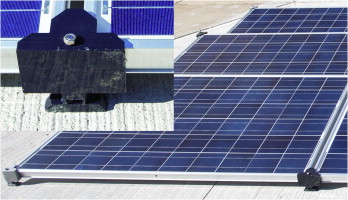J.M.Pearce (talk | contribs) |
J.M.Pearce (talk | contribs) mNo edit summary |
||
| (4 intermediate revisions by the same user not shown) | |||
| Line 1: | Line 1: | ||
{{MOST}} | {{MOST}} | ||
{{Pearce-pubs}} | |||
==Source== | ==Source== | ||
| Line 25: | Line 26: | ||
|Image:xwire3.jpg|Fig 3: Finished system | |Image:xwire3.jpg|Fig 3: Finished system | ||
}} | }} | ||
* Source code | * Source code for STLs and OpenSCAD: https://www.youmagine.com/designs/open-source-racking-for-solar-cell-modules | ||
==See also== | ==See also== | ||
* [[3-D Printing Solar Photovoltaic Racking in Developing World]] | |||
* [[Distributed manufacturing with 3-D printing: a case study of recreational vehicle solar photovoltaic mounting systems]] | * [[Distributed manufacturing with 3-D printing: a case study of recreational vehicle solar photovoltaic mounting systems]] | ||
* [[3-D printable photovoltaic module spacer]] | |||
* [[Design of Post-Consumer Modification of Standard Solar Modules to Form Large-Area Building-Integrated Photovoltaic Roof Slates]] | |||
{{Solar navbox}} | {{Solar navbox}} | ||
Revision as of 09:45, 19 November 2017
Source
- B.T. Wittbrodt & J.M. Pearce. Total U.S. cost evaluation of low-weight tension-based photovoltaic flat-roof mounted racking. Solar Energy 117 (2015), 89–98. DOI: 10.1016/j.solener.2015.04.026 open access
Abstract

The economics in the U.S. of solar photovoltaic (PV) systems is changing rapidly as the cost per unit power of PV modules has dropped quickly. These costs reductions have two important results: marked decrease in levelized cost of electricity (LCOE) into ranges competitive or better than traditional electricity-generation technologies and the economic role of racking has been gaining prominence relative to that of modules. As the relative importance of costs of PV racking has been marginal historically, there has been relatively little progress on reducing the materials and costs associated with it, which has caused racking to contribute to a significant portion of costs of entire PV systems. In order to overcome this challenge this study investigates a novel low-weight PV racking system for commercial rooftops based on crossed cables (X-wires) and compares it to racking systems already available on the market on capital costs, labor costs for installation, and technical specifications such as adaptability and power packing factor. The results of over 80% cost reduction and 33% increase in power density are presented and conclusions are drawn about the potential for tension-based racking systems to further reduce total PV systems costs on commercial flat roof tops resulting in LCOE savings of $0.01–$0.02/kW h.
Highlights
- Solar photovoltaic (PV) costs falling rapidly, racking costs are not.
- PV racking contributes a significant portion of cost for PV systems.
- Investigated low-weight PV racking system for commercial rooftops.
- System based on crossed cables (X-wires).
- Found over 80% cost reduction and 33% increase in energy density.
X-Wire Racking System
- Source code for STLs and OpenSCAD: https://www.youmagine.com/designs/open-source-racking-for-solar-cell-modules
See also
- 3-D Printing Solar Photovoltaic Racking in Developing World
- Distributed manufacturing with 3-D printing: a case study of recreational vehicle solar photovoltaic mounting systems
- 3-D printable photovoltaic module spacer
- Design of Post-Consumer Modification of Standard Solar Modules to Form Large-Area Building-Integrated Photovoltaic Roof Slates


















